Results 1 to 1 of 1
Thread Information
Users Browsing this Thread
There are currently 1 users browsing this thread. (0 members and 1 guests)
-
03-12-2019, 02:30 PM #1
On the border, migrant apprehensions happen around the clock
On the border, migrant apprehensions happen around the clock
John C Moritz, Corpus Christi Caller Times Published 11:39 a.m. MT March 12, 2019
The Border Patrol's Rio Grande Sector is the nation's busiest, and at apprehensions are at a five-year high.
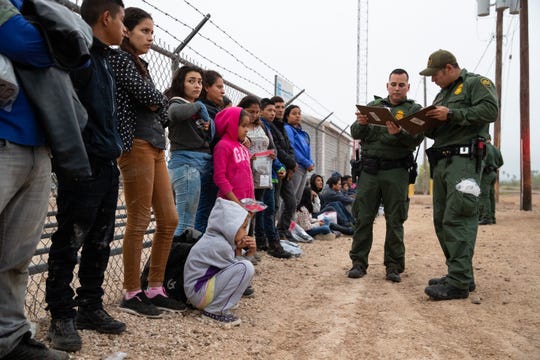
A large group of migrant family wait along the side of the road to be transported after turning themselves in to Border Patrol agents in Penitas, Texas, on Tuesday, Feb. 26, 2019. (Photo: Courtney Sacco/Caller-Times)
HIDALGO COUNTY, Texas — The predawn darkness, aided by fog and mist, masked the sharp thorns from the wall of mesquite trees and the knee-deep holes that dotted a weed-covered ravine in the farm country about a mile from the Rio Grande.
But Hermann Rivera pushed through the bramble and made his way out of the ditch toward the red and blue lights on three vehicles from the U.S. Customs and Border Patrol and joined his fellow agents. Sitting and leaning against one of the trucks were seven men who had just been taken into custody.
It was 6:15 a.m., about 45 minutes before sunrise.
"From here, they'll be taken to the center in McAllen. They'll be processed. Their records will be checked," Rivera said. "They'll go to court, and there's a good chance they'll be deported."
Here's what the nation's busiest Border Patrol sector along the U.S./Mexico border looks like in Texas. Courtney M Sacco, Corpus Christi Caller-Times
Apprehensions around the clock
The early morning apprehensions were the first of eight operations that Rivera and Roderick Kise, a CBP public affairs officer, would take part in before noon. In all, they were part of taking into custody more than 70 people suspected of entering the United States without legal authorization. Nearly all had come from countries in Central America that are south of Mexico, and nearly were accompanied by family members.
And, the eight operations were just a fraction of the activity that takes place in the Border Patrol's Rio Grande Sector, which covers 34,000 square miles from Texas' Coastal Bend to Falcon Dam in Starr County and employs more than 3,000 agents working around-the-clock shifts.
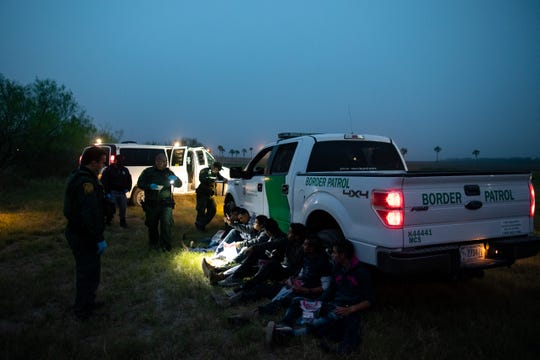
Border Patrol agents take a group of migrants in to custody near Mission, Texas, after tracking them though a field on Tuesday, Feb. 26, 2019. (Photo: Courtney Sacco/Caller-Times)
In terms of apprehensions, the sector is at its busiest in years. In the 12-month period that ended Sept. 30, more than 63,000 adults and accompanied children were apprehended in the sector. In addition, 75,000 men and women without families were taken in along with more than 23,000 unaccompanied children taken into custody during the same period.
Together, that's about half of all apprehensions in the nine Border Patrol sectors from Brownsville to San Diego.
But the heightened activity is not limited to the lower Rio Grande Valley. The U.S. Customs and Border Patrol on Tuesday released staggering statistics showing that apprehensions from Brownsville at the mouth of the Rio Grande to the Pacific Ocean in San Diego, are taking place at a pace not seen since 2005.
The men taken into custody before sunrise in Hidalgo County told agents they were either from Ecuador, Honduras and El Salvador. They had crossed into the United States from Mexico that morning.
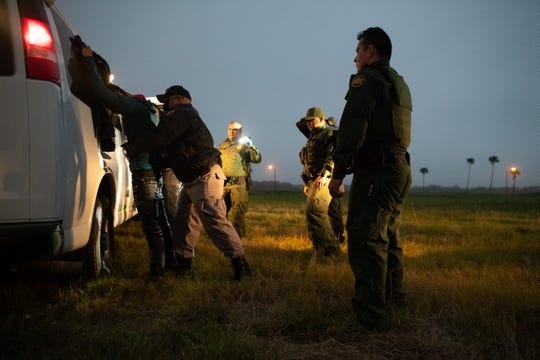
A migrant is searched before being transported after being taken in to custody by Border Patrol near Mission, Texas, after tracking them trough a field on Tuesday, Feb. 29, 2019. (Photo: Courtney Sacco/Caller-Times)
They were likely hoping to blend into the heavily Hispanic South Texas population and make their way to some place where they could find work, Kise said.
The men were spotted with the aide of what agents call a "scope truck," which is shorthand for the hydraulic Mobile Video Surveillance Systems mounted in the bed of a Ford F-150 4-by-4 that can be raised nearly 40 feet in the air.
At the top is an infrared camera that can see at night and sends grainy images to the laptop affixed the dashboard in the truck's cab. The scope truck's operator radioed the siting, which brought in the border patrol vehicles that bounced along a loose network of unpaved roads and trails.
THE WALL: An in depth-examination of Donald Trump's border planned wall
Once contact with the agents was made, the men did not resist being taken into custody. While they waited for a van large enough to take them all to McAllen, the men were given clear plastic bags to store their belongings.
They were told to remove the laces from their shoes "for safety reasons," Rivera said.
Most, if not all, had identification papers from their home countries.
 Border Patrol agents standing along the border wall near Penitas, Texas, look down at other agents after taking two migrants in to custody on Tuesday, Feb. 26, 2019. (Photo: Courtney Sacco/Caller-Times)
Border Patrol agents standing along the border wall near Penitas, Texas, look down at other agents after taking two migrants in to custody on Tuesday, Feb. 26, 2019. (Photo: Courtney Sacco/Caller-Times)
The fencing: 'At least it slows them down'
Rivera and Kise cruised the southernmost reaches of Hidalgo County in a late model but well worn government-owned Chevrolet Tahoe responding to radio calls reporting sightings of people who had just crossed the river or checking out locations where apprehensions had been made in the past.
Stopping on a pocked caliche levee road in the border town of Penitas, Rivera walked along the bollard, or steel post, fencing erected about a decade ago. Atop the levee, the fencing is unimposing and rises only 8 or 10 feet above the road.
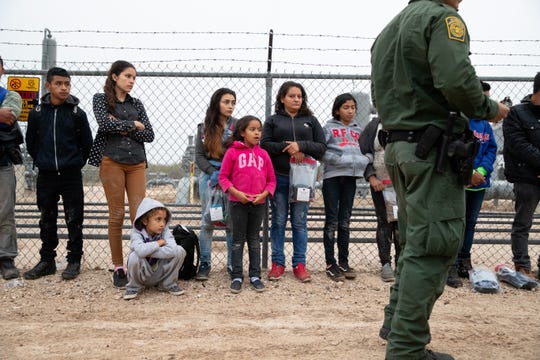 A large group of migrant families wait along the side of the road to be transported after turning themselves in to Border Patrol agents in Penitas, Texas, on Tuesday, Feb. 26, 2019. (Photo: Courtney Sacco/Caller-Times)
A large group of migrant families wait along the side of the road to be transported after turning themselves in to Border Patrol agents in Penitas, Texas, on Tuesday, Feb. 26, 2019. (Photo: Courtney Sacco/Caller-Times)
But peering through the pickets down toward the heavily wooded flood plain leading to the river showed a different picture. The fence caps a concrete wall at least two stories high.
"Before this wall structure went in, we had a lot of narcotic traffic right here," said Rivera, an 18-year-veteran of the Border Patrol. "It was real bad. They'd come across the river and just keep going. This structure really helped mitigate that. At least it slows them down.
We need this, along with the other technology, to give us a chance."
As Rivera spoke, agents were taking two men into custody at the edge of the woods below. One of the agents found a long yellow nylon rope that had been knotted every few feet. A small tree branch was tied at one end, which the men had planned to throw over the bollard fence to act as grappling hook so they might scale up the concrete wall.
'We've got two bodies!'
But the fencing in the Hidalgo County part of the sector is sporadic. There is none near the Anzalduas International Bridge in the town of Rincon Bend, where the swift currents of the Rio Grande cut a sharp, horseshoe-shaped channel. The razor-sharp concertina wire installed when additional federal troops were sent to the border last fall was removed in December amid assertions by local officials that it posed a danger to U.S. citizens and to wildlife.
Just after 9:30 a.m., Rivera steered the Tahoe along a dirt road through the woods when Kise called out, "We've got two bodies!" That's Border Patrol shorthand for a sighting of people suspected of being in the United States without authorization.
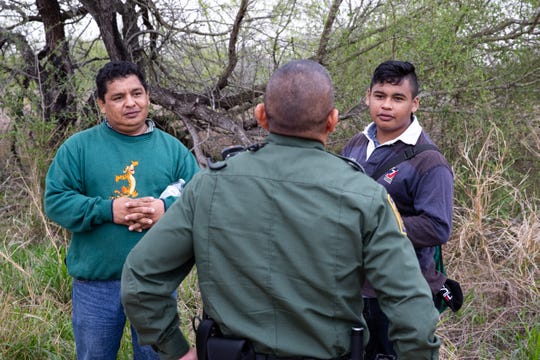 Border Patrol Agent Hermann Rivera takes a fourth-four year-old Honduran man and his 16-year-old son in to custody who had been walking lost for hours after crossing the river from Mexico near Mission TX, on Tuesday, Feb. 28, 2019. (Photo: Courtney Sacco/Caller-Times)
Border Patrol Agent Hermann Rivera takes a fourth-four year-old Honduran man and his 16-year-old son in to custody who had been walking lost for hours after crossing the river from Mexico near Mission TX, on Tuesday, Feb. 28, 2019. (Photo: Courtney Sacco/Caller-Times)
Both Kise, an Army retiree who was a tank gunner during Operation Desert Storm, and Rivera speak fluent Spanish and they got out of the Tahoe and instructed the men to walk toward them. The encounter was not confrontational. The men, a 44-year-old father and his 16-year-old son, said they'd been wandering the area since before dawn. They were lost and thirsty.
Rivera opened the Tahoe tailgate and pulled two water bottles from an open case. The men, who traveled from Honduras through Mexico, thanked him. The agents chatted with the men, learning that they had hoped to connect with family members already in the United States.
A transport van was called in to take them to the McAllen processing center. After the van arrived, Kise and Rivera returned to the Tahoe and headed closer to the river. Coming toward the vehicle was a young woman and four children. The woman began to cry and two of the children, a 5-year-old boy and a 3-year-old girl, clutched each of her hands.
 Border Patrol Agent Hermann Rivera talks with a 22-year-old women from El Salvador and her 5 and 3-year-old children after crossing the Rio Grande Valley from Mexico near Mission, Texas, on Tuesday, Feb. 26, 2019. (Photo: Courtney Sacco/Caller-Times)
Border Patrol Agent Hermann Rivera talks with a 22-year-old women from El Salvador and her 5 and 3-year-old children after crossing the Rio Grande Valley from Mexico near Mission, Texas, on Tuesday, Feb. 26, 2019. (Photo: Courtney Sacco/Caller-Times)
Two boys, ages 9 and 11, carried sip cups filled with milk for the younger ones.
As Rivera talked with the woman, who was 22 and the mother of the younger children, Kise chatted almost playfully with the older boys. They smiled and laughed.
One of them pointed at the name tag above the breast pocket on Rivera's Army-green uniform, saying they had the same last name.
"Maybe you're cousins," Kise said to him with a laugh in Spanish.
The woman, no longer crying, told Rivera they had come from El Salvador. The older boys told Kise they'd been given the phone number of their mother, believed to be living in New York. The boys said they had not seen her in nearly four years.
"The mother likely made arrangements for them to come here," Kise said.
 Border Patrol Agents take in to custody migrants shortly after crossing the river from Mexico near Mission TX, on Tuesday, Feb. 28, 2019. (Photo: Courtney Sacco/Caller-Times)
Border Patrol Agents take in to custody migrants shortly after crossing the river from Mexico near Mission TX, on Tuesday, Feb. 28, 2019. (Photo: Courtney Sacco/Caller-Times)
The same van that came for the men would also transport the woman and children. Several yards down the road, Rivera found the trail leading up from the river where the migrants had entered Texas. He had been there many times before.
Across the river in the Mexican city of Reynosa, music was coming from the neighborhood.
"The smuggler takes them down that path," Rivera said, pointing to a clearing on the Mexican side about 150 yards away. "They all get into an inflatable raft and the smuggler takes them across. He tells them to go up this trail and turn left at the road. Then they're on their own."
'We get into plenty of scuffles'
While the apprehensions in the desolate section Rincon Bend were uneventful, a different scene would play out on a working farm near a levee road a few miles away.
Several Border Patrol were already in place when Kise and Rivera responded a radio call about men hiding in the brush along a field of crops.
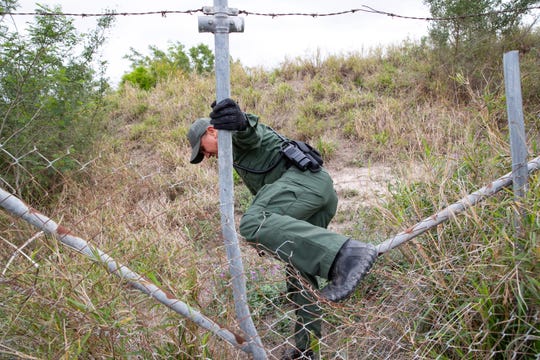 Border Patrol Agent Hermann Rivera climbs through a fence as he assists other agents searching an area in Mission, Texas, for five migrants who ran from agents on Tuesday, Feb. 28, 2019. (Photo: Courtney Sacco/Caller-Times)
Border Patrol Agent Hermann Rivera climbs through a fence as he assists other agents searching an area in Mission, Texas, for five migrants who ran from agents on Tuesday, Feb. 28, 2019. (Photo: Courtney Sacco/Caller-Times)
One agent was carrying a military rifle. All of the border patrol agents wear side arms. But earlier in the day, Rivera said they are seldom drawn unless they encounter suspected drug traffickers.
"We get into plenty of scuffles, but our pistols never come out of our holsters," he said. "We're trained to use other methods."
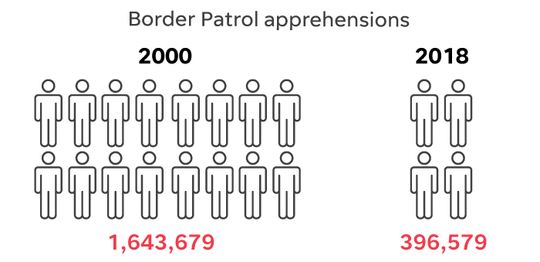 Border apprehensions (Photo: USA TODAY)
Border apprehensions (Photo: USA TODAY)
At the farm, agents could be heard shouting instructions in Spanish to men believed to be burrowed under some brush. As Rivera and Kise tromped past a section of chain-link fence that had been topped by concertina wire but had fallen down and into a thick field, the men had given up.
Two men handcuffed together followed by to other men handcuffed together and one by himself were led from the weeds and sat along the bollard fencing. There was no pleasant chatting between the agents and migrants, but also no hostility.
 Border Patrol agents take a group of migrants in to custody after they ran in to a filed in Mission, Texas, on Tuesday, Feb. 26, 2019. (Photo: Courtney Sacco/Caller-Times)
Border Patrol agents take a group of migrants in to custody after they ran in to a filed in Mission, Texas, on Tuesday, Feb. 26, 2019. (Photo: Courtney Sacco/Caller-Times)
1,000 apprehensions a day
The Border Patrol said the Rio Grande sector is by far the most active region in the United States, especially in recent weeks. According to a Feb. 28 news release, the sector has been averaging about 1,000 apprehensions a day and if the pace continues, some 240,000 people without legal authorization to be in the country will be taken into custody in the sector during the 12-month period ending Sept. 30, 2019.
But not all sightings end in apprehension.
About halfway through their shift on Tuesday, Kise and Rivera responded to a call that several people had been seen running though a remote area that a generation ago was a popular place for outdoor parties and celebrations.

Border Patrol Agent Hermann Rivera and other agents search and area of brush in Penitas, TX for migrants spotted running in the area on Tuesday, Feb. 26, 2019. (Photo: Courtney Sacco/Caller-Times)
The field was overgrown with weeds and mesquite. The agents combed their way through, stopping to peek under piles of dead trees and abandoned structures. They stopped to listen for movement.
They found nothing and headed back to the Tahoe. Rivera said they were suspending the search, not giving up on it.
"They'll come back, he said. "It's a matter of time."
https://www.elpasotimes.com/story/ne...as/3140885002/
NO AMNESTY
Don't reward the criminal actions of millions of illegal aliens by giving them citizenship.
Sign in and post comments here.
Please support our fight against illegal immigration by joining ALIPAC's email alerts here https://eepurl.com/cktGTn
Similar Threads
-
Migrant Family Border Apprehensions Skyrocket 270 Percent in Nov. over Prior Year
By stoptheinvaders in forum illegal immigration News Stories & ReportsReplies: 0Last Post: 12-08-2018, 01:15 PM -
Bangladeshi Migrant Apprehensions in Laredo Sector Top 500 in 2018
By JohnDoe2 in forum illegal immigration News Stories & ReportsReplies: 2Last Post: 08-07-2018, 07:25 PM -
'Clock Boy' Gets Clock Cleaned in Free-Speech Victory
By GeorgiaPeach in forum General DiscussionReplies: 0Last Post: 02-04-2017, 02:50 PM -
Migrant Family Apprehensions Up 230 Percent on Border
By Jean in forum illegal immigration News Stories & ReportsReplies: 0Last Post: 12-19-2016, 05:44 PM -
Yuma Border patrol release number of illegal border crosser apprehensions and drugs
By JohnDoe2 in forum illegal immigration News Stories & ReportsReplies: 0Last Post: 12-23-2011, 06:10 PM


 LinkBack URL
LinkBack URL About LinkBacks
About LinkBacks




 Reply With Quote
Reply With Quote


Oklahoma House passes bill making illegal immigration a state...
04-19-2024, 05:14 AM in illegal immigration News Stories & Reports